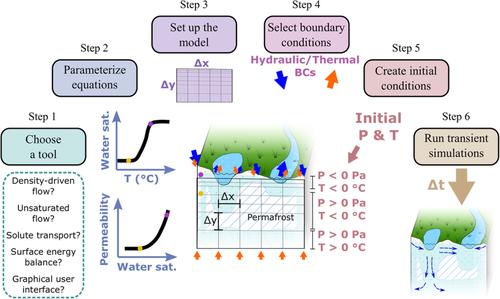当前位置:
X-MOL 学术
›
WIREs Water
›
论文详情
Our official English website, www.x-mol.net, welcomes your
feedback! (Note: you will need to create a separate account there.)
Guidelines for cold‐regions groundwater numerical modeling
WIREs Water ( IF 6.8 ) Pub Date : 2020-07-08 , DOI: 10.1002/wat2.1467 Pierrick Lamontagne‐Hallé 1 , Jeffrey M. McKenzie 1 , Barret L. Kurylyk 2 , John Molson 3 , Laura N. Lyon 1
WIREs Water ( IF 6.8 ) Pub Date : 2020-07-08 , DOI: 10.1002/wat2.1467 Pierrick Lamontagne‐Hallé 1 , Jeffrey M. McKenzie 1 , Barret L. Kurylyk 2 , John Molson 3 , Laura N. Lyon 1
Affiliation

|
The impacts of ongoing climate warming on cold‐regions hydrogeology and groundwater resources have created a need to develop groundwater models adapted to these environments. Although permafrost is considered relatively impermeable to groundwater flow, permafrost thaw may result in potential increases in surface water infiltration, groundwater recharge, and hydrogeologic connectivity that can impact northern water resources. To account for these feedbacks, groundwater models that include the dynamic effects of freezing and thawing on ground properties and thermal regimes have been recently developed. However, these models are more complex than traditional hydrogeology numerical models due to the inclusion of nonlinear freeze–thaw processes and complex thermal boundary conditions. As such, their use to date has been limited to a small community of modeling experts. This article aims to provide guidelines and tips on cold‐regions groundwater modeling for those with previous modeling experience.
中文翻译:

寒冷地区地下水数值模拟指南
持续的气候变暖对寒冷地区水文地质学和地下水资源的影响导致需要开发适应这些环境的地下水模型。尽管多年冻土被认为相对不渗透地下水,但多年冻土融化可能导致地表水渗透,地下水补给和水文地质连通性潜在增加,从而影响北部水资源。为了解决这些反馈问题,最近开发了地下水模型,其中包括冻融对地面特性和热力状态的动态影响。但是,由于包含了非线性冻融过程和复杂的热边界条件,因此这些模型比传统的水文地质数值模型更为复杂。因此,迄今为止,它们的使用仅限于小型的建模专家社区。本文旨在为有过建模经验的人提供寒冷地区地下水建模的指南和技巧。
更新日期:2020-07-08
中文翻译:

寒冷地区地下水数值模拟指南
持续的气候变暖对寒冷地区水文地质学和地下水资源的影响导致需要开发适应这些环境的地下水模型。尽管多年冻土被认为相对不渗透地下水,但多年冻土融化可能导致地表水渗透,地下水补给和水文地质连通性潜在增加,从而影响北部水资源。为了解决这些反馈问题,最近开发了地下水模型,其中包括冻融对地面特性和热力状态的动态影响。但是,由于包含了非线性冻融过程和复杂的热边界条件,因此这些模型比传统的水文地质数值模型更为复杂。因此,迄今为止,它们的使用仅限于小型的建模专家社区。本文旨在为有过建模经验的人提供寒冷地区地下水建模的指南和技巧。











































 京公网安备 11010802027423号
京公网安备 11010802027423号